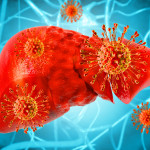AbbVie’s new Mavyret (glecaprevir/pibrentasvir) coformulation taken for 8 or 12 weeks led to a sustained response in almost all HIV-positive people with hepatitis C in the EXPEDITION-2 study, according to a presentation at the 9th International AIDS Society Conference on HIV Science (IAS 2017) taking place this week in Paris.
Mavyret demonstrated an overall cure rate of 98 percent, and all study participants without liver cirrhosis were cured with an eight-week course of therapy, reported Karine Lacombe, MD, of Saint-Antoine Hospital in Paris.
Glecaprevir is a hepatitis C virus (HCV) protease inhibitor and pibrentasvir is an NS5A inhibitor. Both are pangenotypic, meaning they are active against all HCV genotypes. The two drugs are combined in a once-daily pill. The Food and Drug Administration is expected to approve the coformulation, to be marketed as Mavyret, in August. [UPDATE: Mavyret was approved on August 3, 2017]
Direct-acting antivirals (DAAs) used in interferon-free regimens have led to a paradigm shift in the treatment of hepatitis C, making it shorter, better tolerated and much more effective than the older interferon-based therapy. DAAs can now cure most people with all HCV genotypes in 12 weeks, but a shorter course of treatment could improve adherence and reduce cost.
People with HIV and HCV coinfection did not respond as well as HIV-negative people to interferon and therefore were regarded as difficult to treat. Studies in the era of DAAs, however, have shown that people living with HIV can do just as well on interferon-free regimens as those without HIV and are no longer considered a “special population.” But it is important to be aware of potential drug interactions between DAAs and antiretrovirals used to treat HIV.
The Phase III EXPEDITION-2 study enrolled 153 HIV-positive people with chronic hepatitis C in the United States, Europe and Russia. More than 80 percent were men, most were white and the median age was approximately 45 years. About two thirds had HCV genotype 1 (of whom a majority had harder-to-treat subtype 1a); 17 percent had genotype 3; and 11 percent had genotype 4. Only a small number had genotypes 2 or 6.
Sixteen participants (10 percent) had liver cirrhosis, and most of the rest had absent or mild fibrosis. Nearly 20 percent had previously been treated with interferon and ribavirin, and three had also used Sovaldi (sofosbuvir).
Study participants had well-controlled HIV with a median CD4 count of nearly 600 cells/mm3. All but nine of them were on antiretroviral therapy. About three quarters were taking the integrase inhibitors Isentress (raltegravir) or Tivicay (dolutegravir), which were shown to have minimal interactions with the drugs in Mavyret.
All study participants were treated with Mavyret; there was no placebo control group. People without cirrhosis received treatment for eight weeks, while those with cirrhosis were treated for 12 weeks.
Current treatment guidelines from the American Association for the Study of Liver Diseases (AASLD) do not recommend shorter treatment for people with HIV/HCV coinfection, and this is the first study looking at such a short course of therapy for this population.
Mavyret was shown to be highly effective, with an overall sustained virological response rate of 98 percent. Continued undetectable HCV RNA 12 weeks after completion of treatment, known as SVR12, is considered a cure. The cure rate was 99 percent for people without cirrhosis who were treated for eight weeks, with no cases of virological treatment failure observed in this group.
A single patient with hard-to-treat HCV genotype 3 and cirrhosis who reported less than complete adherence experienced virological failure during treatment. Another participant had missing data at 12 weeks posttreatment but returned for care at 24 weeks posttreatment and was found to be cured.
Mavyret was generally safe and well tolerated, and side effects were similar to those seen in parallel studies of HIV-negative people. The most common adverse events were fatigue, nausea, headache and nose and throat inflammation.
“These results suggest that the glecaprevir/pibrentasvir regimen could be the first eight-week pangenotypic treatment option for HCV/HIV-1–coinfected patients without cirrhosis,” the researchers concluded.
“I think it’s a very promising combination even for patients who have failed previous treatment, ” Lacombe told Hep.






Comments
Comments